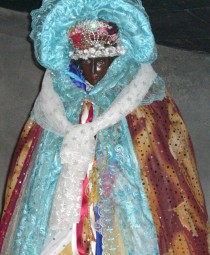Translation Romani has decided to maintain use of the word Romani in all language versions of this website, inclusively and in reference both to the language and people of all the diverse ethnic communities throughout the world, i.e. Roma, Sinti, Manuš, Calé, Romanichal, Kalé, and many others. Please read the important notes from our translators for explanations and other translations currently in use locally, nationally or regionally.
Close this box.

|
Romani Culture in Translation
|
Romani cultural expression is as dynamic and diverse as the many peoples it embraces. Oral traditions sustain a lively storytelling culture. Sacred texts such as the Bible can be read in Romani. Romani artists have contributed to performance and visual arts, as well as literature, in many modes and languages.
|
Paramiči is the Kalderaš Romani word for "story", "legend" or "tale". Stories and tales in the oral tradition are the dynamic foundation on which much Romani cultural expression is historically based, in all dialects, all around the world. Many of these stories have been transcribed and some translated.
Translation of the Bible into Romani merges into a solid, centuries-old tradition of Bible translation and commentary. Many Romani have adopted Roman Catholicism and Pentecostal forms of worship; others practice the Orthodox Christian and Muslim faiths.
Historically, Romani musical traditions have had an important influence on national music and on composers, musicians and performers of various types and genres worldwide: jazz manouche (manuš), flamenco, folk, classical, brass band, wedding music, as well as pop and rock.
Although puppet theatre enjoys a longer tradition in Romani families and communities, modern Romani performances and productions in theatre and drama, including musicals, have roots in Russia (1931), Macedonia (1970) and Slovakia (1992), as well as in other eastern European countries.
Existing cinematographic production depicting Romani life and culture is predominantly non-Romani. The most well-known Romani film-maker internationally is Tony Gatlif. Documentary production, however, is a growing field, with significant contributions from Romani scholars, activists and communities.
Romani literary expression has often found its voice in poetry, short stories, plays and some novels. Works have been published in the national languages of Romani writers as well as in Romani dialects and in translation. One of the most prolific Romani writers of novels is Matéo Maximoff (France).
Some contemporary Romani visual artists,for example, Katarzyna Pollok (Ukraine/Poland), Ceija Stojka (Austria), Gabi Jimenez (France) and István Szentandrássy (Hungary), create art that reflects the unique historical complexities and shared experiences of Romani identity, as part of the history of world art.
Socially networked websites online clearly constitute the space where many young and active Romani with access to technologies choose to communicate their experiences, identities and collective history, translating into and out of Romani dialects, national languages and often, English.










